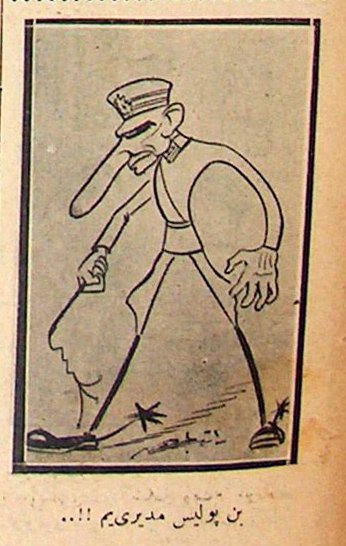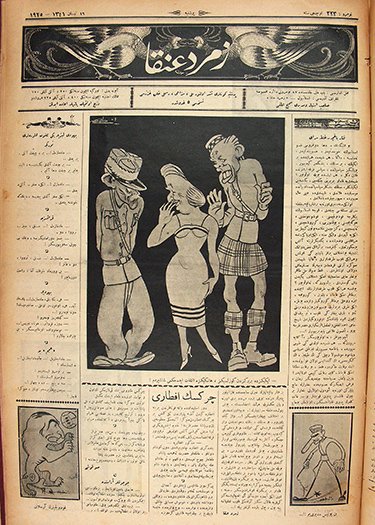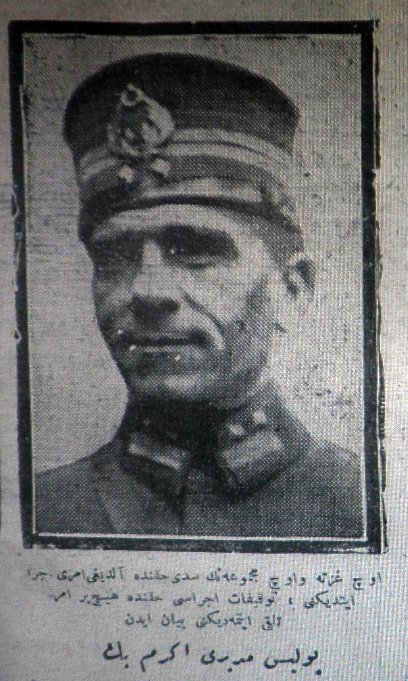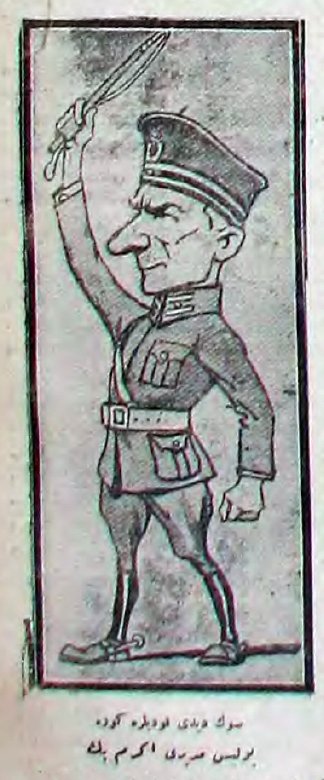78. Today in 1920s Turkey: 16 April 1925 (The Cartoonist’s Armoury Part 3 of 3)

(Cartoon by Ratip Tahir Burak, Zümrüdüanka or “Phoenix,” 16 April 1925, no. 223, page 1.)
Comments:
This is the final installment of a three-part series exploring the methods of symbolic communication used in three different cartoons. I chose these three cartoons for consideration because they all appear on the same page of the journal Zümrüdüanka; they are all the work of the same cartoonist; and they each provide commentary on vastly different subjects.

(Entire page with three cartoons by Ratip Tahir Burak, Zümrüdüanka or “Phoenix,” 16 April 1925, no. 223, page 1.)
Cartoons require a bit of work on the part of their readers who are assumed to possess a fair amount of visual literacy and contextual knowledge to “decipher” or unlock the full potential of their messages. As part of the “Today in 1920s Turkey” mission, I try to provide as much context as is necessary for today’s reader who may occupy a time and/or space that is too distant from the cartoon’s original publication to fully appreciate all that the cartoons are communicating. In addition to these explanations, for the sake of this series, I have also been using these cartoons as examples to illustrate the six “weapons” or “tools” found in a cartoonist’s armory, as outlined by influential art historian, Ernst Gombrich in:
Gombrich, Ernst Hans. “The Cartoonist’s Armoury.” In: Meditations on a Hobby Horse, and Other Essays on the Theory of Art, 127-142. London: Phaidon Press, 1994.
To catch up to the discussion refer to parts 1 and 2 of this series:
#76: The Cartoonist’s Armoury Part 1 of 3
#77: The Cartoonist’s Armoury Part 2 of 3
… and as a reminder, below are the categories of “weapons” or “tools” to be found in the cartoonist’s armory. Each of the three cartoons discussed in these posts exhibits at least one of these methods of expression.
- Figures of Speech
- Condensation and Comparison
- Portrait Caricature
- The (Political) Bestiary
- Natural Metaphors
- Powerful Contrasts

(Cartoon by Ratip Tahir Burak, Zümrüdüanka or “Phoenix,” 16 April 1925, no. 223, page 1.)
Let us now return to the third and final cartoon of this series. The cartoon at hand (above) presents another example of “Portrait Caricature”. The image consists of a man standing in an aggressive manner with his legs apart and arms puffed out like a rooster. He holds a whip in his right hand and wears cowboy-esque spurs on his boots. He has very deep-set eyes and a nose the size of an arm. Each of these attributes constitutes an exaggerated feature associated with the “victim” represented by the caricature and each exaggeration means something. The man’s dark eyes suggest a sinister character. His elongated nose renders him ugly and silly looking and therefore should be considered an insult or a sign of the artist’s disdain for this person. The man’s confrontational stance suggests he is an antagonist—an identification supported by the inclusion of a whip and boot spurs. The man wears an officer’s uniform and hat and since the whip and spurs are foreign to such a uniform these accessories are likely merely “props” fictitiously thrust upon the man to add to his evil demeanor.
Below the cartoon are the words “I’m the Head of Police!!” (Ben Polis Müdürüyüm!!). Written in the first person, the “quote” is understood to be spoken by the man in the cartoon. The simplicity of the man’s declaration mimic's childish banter and claims. If he is the head of police, that should be so obvious that he does not need to assert it. In making the cartoon assert this claim so directly, the very authority it represents becomes questionable and diminished. Perhaps then “Powerful Contrasts” are at work as well in this caricature. We are presented with a Chief of Police in name (expressed through text), presumably tasked with serving and protecting his community; yet we are also presented with a man who seems to himself be violent and far from peaceful (expressed through image).
So who is this Head of Police and why might this cartoonist be targeting him for a negative caricature? To find out, I turned to other journals published around that time to see if he comes up in other news stories. And indeed, I found stories and other caricatures about him. The daily newspaper, Cumhuriyet (“Republic”) ran a story on 7 March 1925 about the new censorship law passed just days ago on 4 March. According to this story, a certain Mr. Ekrem, Head of Police had already shut down five newspapers and three journals. This is our guy. And for comparison, here is the photograph included in the story.

(Photograph of Head of Police, Ekrem Bey. Cumhuriyet or “Republic,” 7 March 1925, no. 300, page 1.)
Like his caricature, this man has deep-set, heavily shaded eyes, a pretty large nose, clean-shaven face, and the same police uniform. Given his involvement in enforcing censorship laws and the fact that he has aided in shutting down so many publications makes him a natural enemy of publishers and cartoonists alike as no cartoonist wants to work under the threat of punishment or unemployment.
But that’s not all. Looking to even more recent publications we find out that this man has made headlines lately for something completely different. Stories from 9 April (Cumhuriyet), 12 April (Cumhuriyet) and 13 April (Akbaba) report that this same Head of Police, Mr. Ekrem, beat up the Head of the Fire Department. This explains why his caricature depicts him wielding a whip! In fact, Cumhuriyet also featured a cartoon of Ekrem Bey holding up a whip in a threatening manner:

(“Head of Police, Mr. Ekrem according to recent gossip,” Cumhuriyet or “Republic,” 12 April 1925, no. 336, page 1.)